Mammillaria cactus: types and subtleties of care
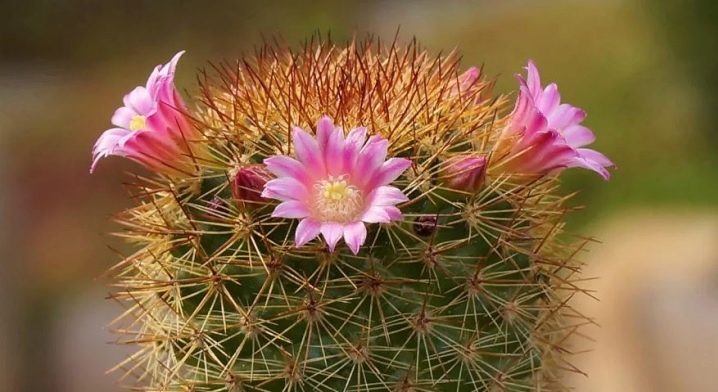
A cactus can be called that plant that pleases flower growers with its beauty, ease of care and unpretentiousness. Mammillaria is an interesting representative of the flora. The popularity of this indoor flower is justified not only by the peculiarities of cultivation, but also by the fact that it can become a successful addition to the interior.
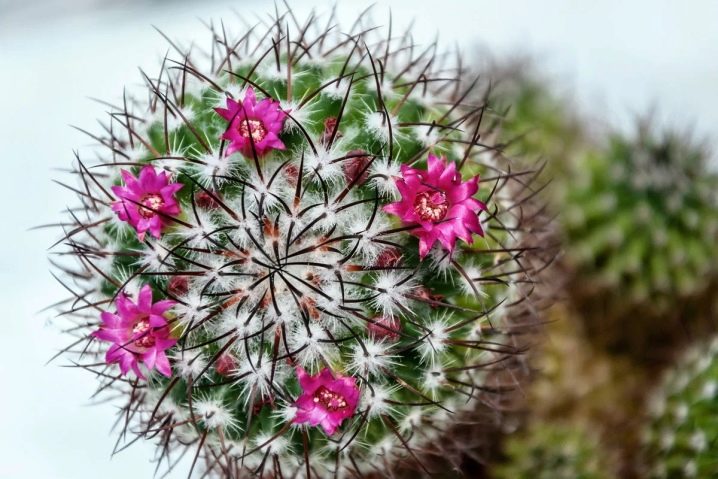
Description
Mammillaria cactus takes pride of place among indoor plants. It blooms rarely, but this spectacle is capable of captivating with its exquisite beauty. Most often, this representative of the flora grows in regions with an arid climate. The plant reaches 0.2 m in height and 0.4 m in width.
The form of mammillaria is varied. She may be both spherical and flat or elongated. Often a cactus is characterized by the presence of longitudinal ribs, but this species has a significant difference - tubercles. Thanks to them, the flower can store and retain moisture, as well as resist the effects of the burning direct rays of the sun. The root of the plant is strong and fleshy.


Externally, the indoor flower looks quite interesting due to the fact that it is divided into parts. One part is covered with sharp thorns, and the other is covered with fluffy formations. Usually, the appearance of flowers occurs in a fluffy area.
Blooming cactus red, yellow and white flowers. They are small - with a diameter of 10 to 60 mm. At the end of the flowering phase, mammillaria produces fruits (berries), and later seeds.
Varieties
Exists many varieties of the plant.
- Shide. It is a miniature spherical cactus with a stem diameter of 40 mm. The tubercles of the plant are conical, their length is 10 mm. The center of the mammillaria has no spines; the rest of the area is covered with white hairy formations up to 5 mm long.
The spines are similar in shape to feathers, the stem is densely covered with them. The flowers of the plant are yellowish-white in color, and the fruits are pink. This species is considered branched.
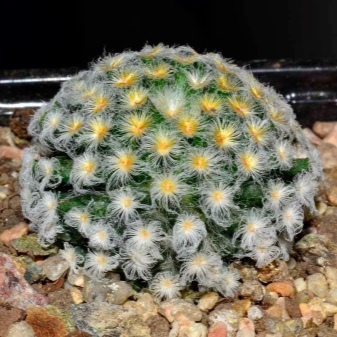
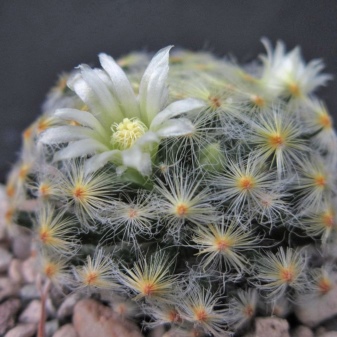
- Mammillaria large papillary is a large type of cactus, since it can reach 0.3 meters in height and 0.14 m in width. The tubercles of this flower have a conical-cylindrical shape, they are not thick and bulging. The branchiness of this plant is not too developed.


- Mammillaria snow-white is also a large variety. At a young age, it has a slightly flattened spherical shape, and at a mature age it looks like a cylinder. The diameter of this plant is 0.14 m, and the height is 0.3 m. The plant is characterized by the presence of thorns growing in the upper part.
The spines are pale pink and small in size. The plant blooms with pale pink flowers, which have burgundy stripes. The fruits of the snow-white mammillaria are deep red.
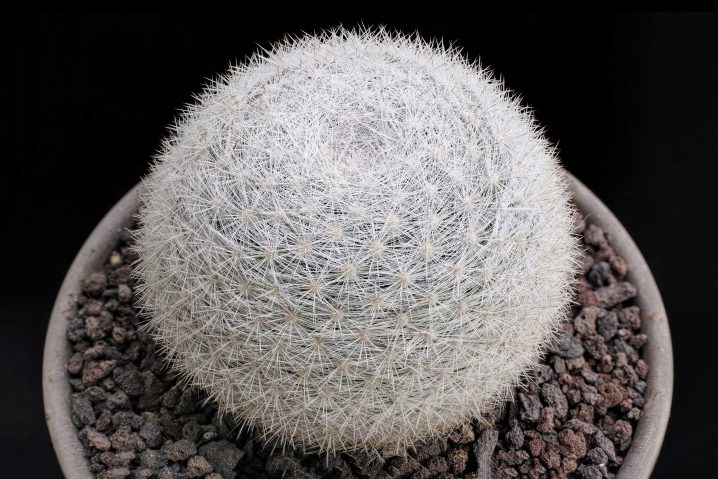
- Mammillaria Teresa refers to weakly branched species, it has an ovoid shape, a height of 4 cm, and a diameter of 3 cm. The tubercles of the plant are cylindrical and not more than 0.6 cm long. The grouping of radial spines occurs in 22-30 pieces, their length is 2 mm, color white, almost transparent. The spines located in the center of the cactus are longer than the previous species and have a yellowish tint. The flowers are large, purple-purple in color.
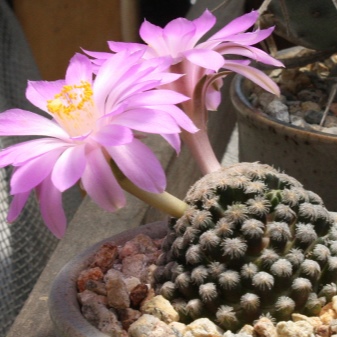
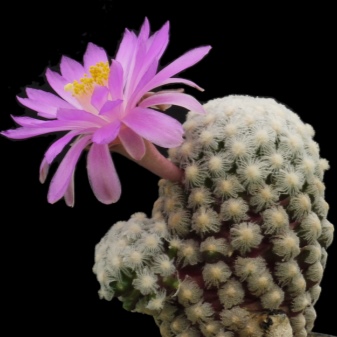
- Mammillaria prickly has a medium size, cylindrical shape, it is not branched. The height of the cactus reaches 0.3 m, and the width is 0.1 m. Tubercles are characterized by the shape of a cone and reach a length of 5 mm.At the tops of the tubercles there are areoles, which are covered with 20 radial white spines and 15 central ones.
The flowers are 1-1.5 cm in size. The fruits have a red color.
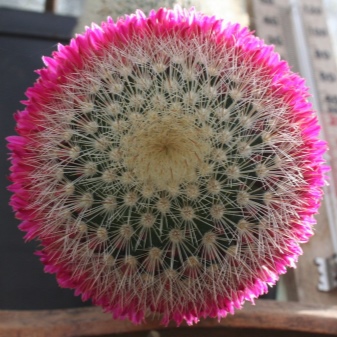
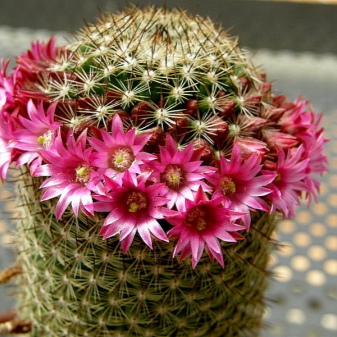
- Rekoi is a medium-sized cactus in the shape of a cylinder. The cactus reaches a height of 12 cm, and in diameter - 6 cm. Areoles include about 30 radial small white spines and 7 larger central ones, painted in dark brown. The plant blooms with rich purple flowers, and produces red fruits.

- Wilda. The flower is characterized by a cylindrical stem and rich color. The plant is strongly bushy, it is covered with thin white bristly spines. Flowers of this species of cactus reach a diameter of 2 cm, they are painted white.
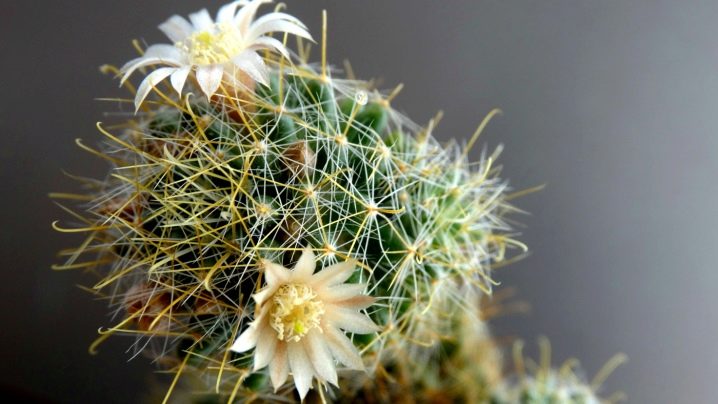
- Prolifera has not only an unusual name, but also an original appearance. An oblong stem of small thickness is covered with yellow spines. They can be not only needle-like, but also hair-like. The prolifera produces white and yellow flowers.
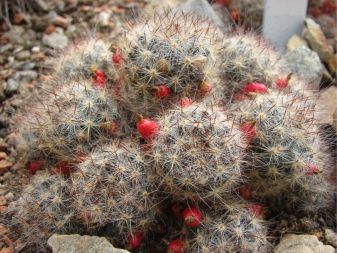
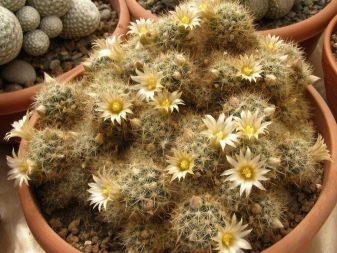
Amateur flower growers can also become owners of mix cacti, which consist of several species of a given plant.
Conditions of detention
Mammillaria cactus belongs to light-loving plants, therefore it must be kept in conditions of sufficient lighting. If the plant is located on the south window, then it should provide shading, as well as ventilate the room as often as possible. Flower growth is also possible under artificial lighting conditions.
In the summer, the balcony of the apartment will be the best location. It is better to give preference to windows in the west and east: the plant will be provided with the necessary amount of light and will not suffer from burns.
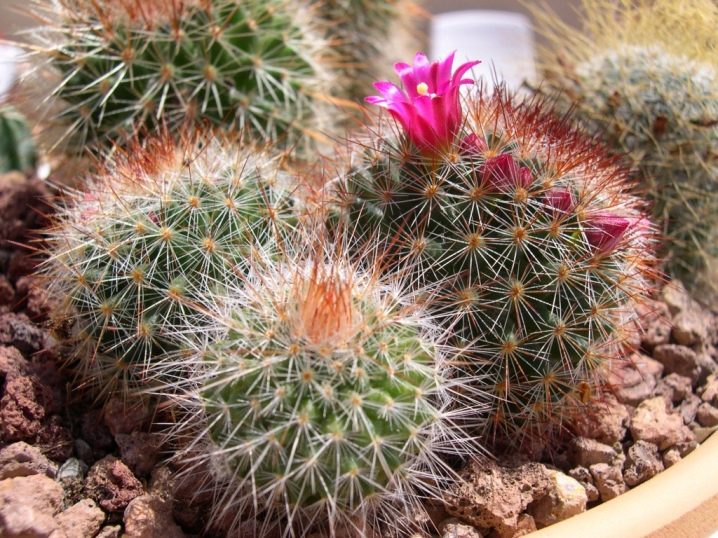
The cactus reacts well to heat, but in winter it should be given some respite. For this, the mammillaria is placed in a room where the air temperature is 10-15 ° C warm. When choosing a substrate, preference should be given to ready-made soil from the store, since it has an optimal percentage of elements for the normal life of this representative of the flora.
Transfer
Mammillaria, like many other indoor flowers, needs a transplant. You need to carry out this procedure with a plant once every 2-3 years... The most favorable time to transplant a cactus is spring. The substrate must be loose, since such a soil is good for air and moisture. When self-preparing the substrate, you need to mix sod and leafy soil with sand in an equal ratio.

The pot should be chosen wide and not too deep, there must be a drainage layer at the bottom to remove excess water. The most suitable is plastic container, since in such a container, mammillaria is not threatened by overdrying and damage to young thin roots. A young plant should be replanted every year. The procedure is carried out by the method of transshipment together with a lump of earth. Immediately after planting, you do not need to water the plant, it is better to do this a few days after the adaptation of the cactus.
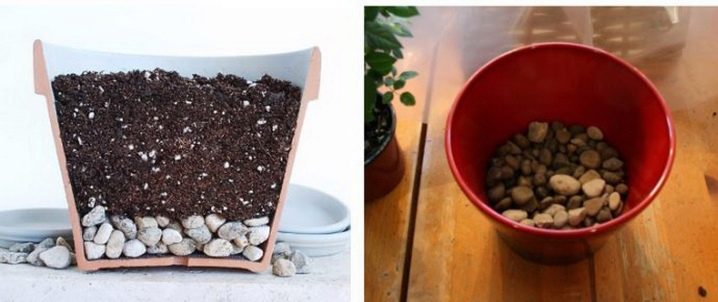
The transplantation procedure is performed step by step.
- Cactus is removed from the ground, a thorough examination of the roots for damage is carried out. If necessary, remove damaged and deformed roots.
- To the bottom of the pot it is necessary to lay out a drainage layer.
- Mammillaria with earthen lump immersed in a container and sprinkled with fresh substrate.
- The soil is compacted fingers and covered with rubble on top, which prevents the stem from rotting.
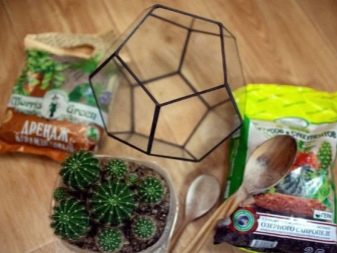
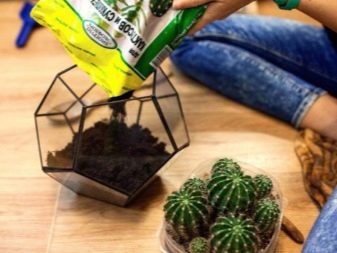
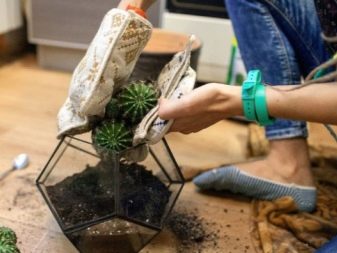
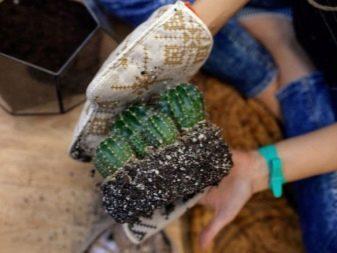
Care
Mammillaria is an ideal option for beginner flower growers, as it does not create any particular difficulties in growing. If you follow simple rules, you can get a cute compact plant that has a unique appearance at the time of flowering. The flower is able to survive in almost any conditions., he does not require frequent watering and constant replanting.
Although the Mammillaria cactus is an unpretentious plant, it needs to be properly looked after at home. Only timely watering, transplantation, fertilization, destruction of pests and infections contribute to the comfortable existence and flowering of this representative of the flora.
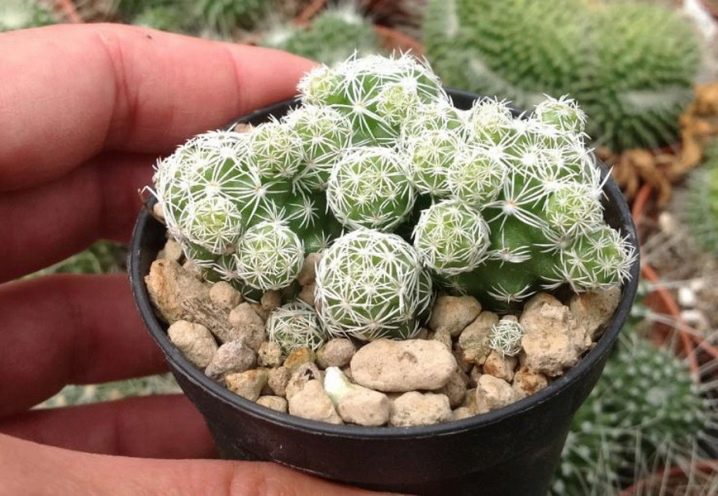
A plant of this species does not require frequent and abundant watering. In winter, irrigation of mammillaria is practically not needed, once every 30 days will be enough. For the winter, cacti fall into a stage of complete dormancy, so it is not recommended to disturb them. And also it is worth remembering that in frosty times this species should not even be rearranged to a new place.
Mammillaria has a negative attitude towards waterlogging. In summer, it should be watered up to 4 times per season. With the onset of autumn, irrigation decreases. The cactus tolerates drought well, but has a favorable attitude to spraying, so they must be carried out periodically.
It is recommended to feed the flower once every 30 days. starting in spring and ending in mid-autumn. It is better to fertilize with purchased mixtures for cacti and succulents from a specialized store. In winter, feeding the cacti is not required.
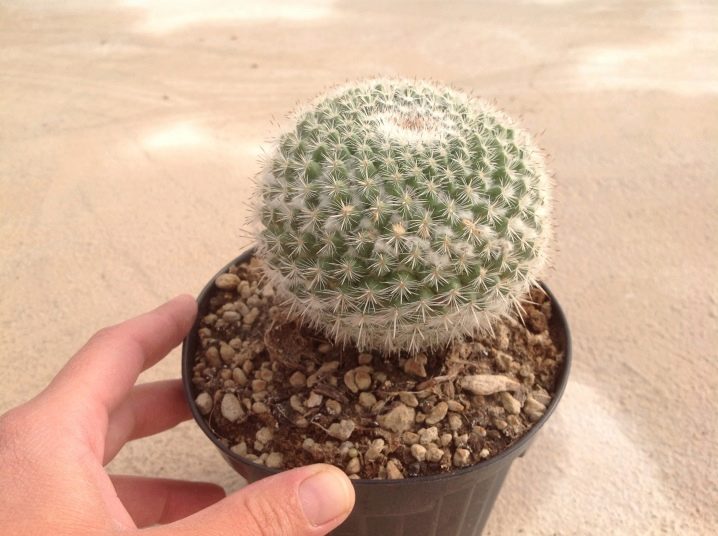
Mammillaria needs pruning only in case of deformations. The main purpose of the procedure is to return a neat shape to a cactus that has grown. The pruning procedure is step-by-step.
- Hand washing and disinfection of the blade.
- Trimming the required part flower. The cut site must be treated with crushed charcoal or pharmacy activated charcoal.
- Sending a cactus for several days in a dark, dry room until the slices dry.
- If the cut material will be used as a landing gear, it will be sent to a dark place for several days. Then the cut of the cactus must be fixed in a glass of water so that the plant is at a distance of 5 mm from the surface of the liquid. When the roots appear, you can plant a young plant.
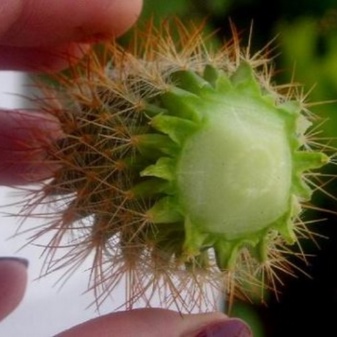
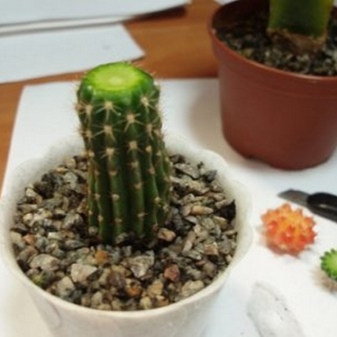
A flowering plant needs special care. If a cactus has bloomed, then it cannot be moved, since in case of anxiety, the plant is capable of dropping its buds. And also in the flowering phase, it is impossible to expose the mammillaria to direct sunlight, it is better to cover the flower with a translucent cloth. Airing is beneficial for the plant. It is worth remembering that when flowering, a cactus does not need to be fertilized and exposed to drafts.
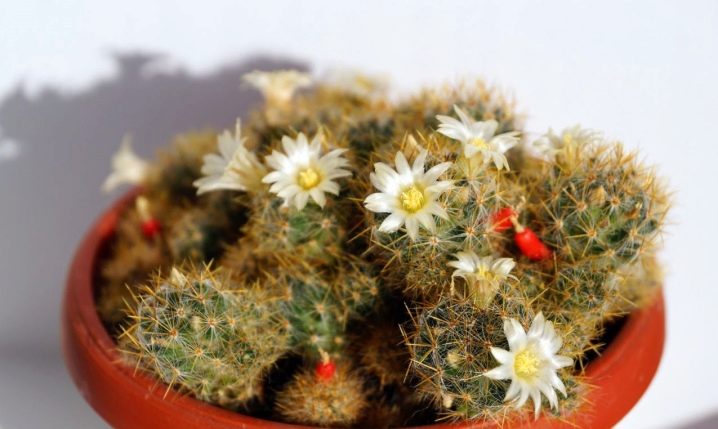
Reproduction
Propagate a mammillaria cactus can be done in the following ways:
- seeds;
- lateral shoots - children.
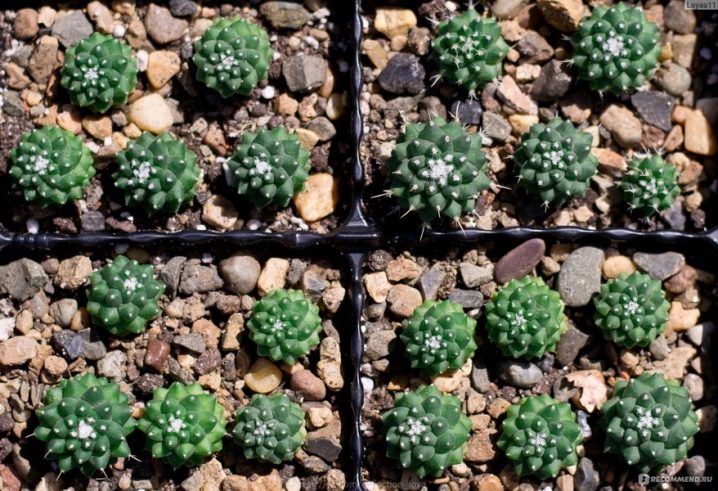
Vegetative reproduction is considered an easy and effective option, since this variety of indoor plant is active in the formation of children. For planting, it is worth preparing flat containers, as well as a mixture of turf soil with sand. The soil should be slightly damp.
Several babies must be carefully separated from the mother cactus and placed on the surface of the substrate. After that, the planting material is pressed into the ground without deepening. Before the mammillaria grows roots, it needs support from small pebbles or twigs.
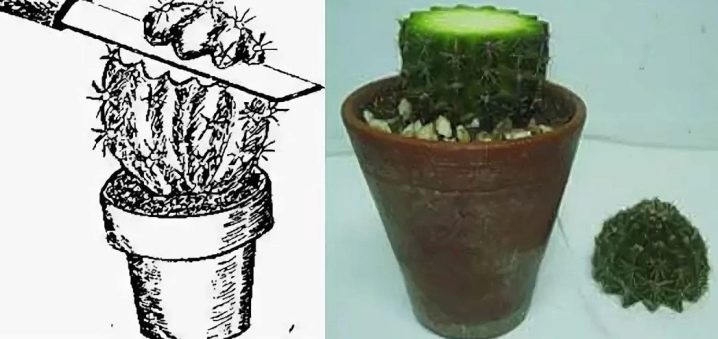
Seed propagation is an option that prevents cacti from degenerating. This method makes it possible to obtain a significant number of young plants.
- First thing it is worth preparing a bowl that has drainage holes.
- Distribute the mixture from sand and sod soil, on which cactus seeds are poured.
- The next step would be construction of a greenhouse, for which the container should be covered with a film or oilcloth. Such a structure helps to maintain the optimum temperature for plantings.
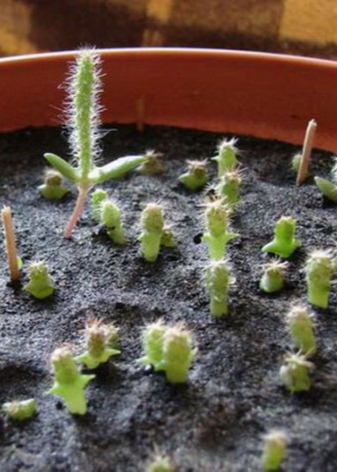
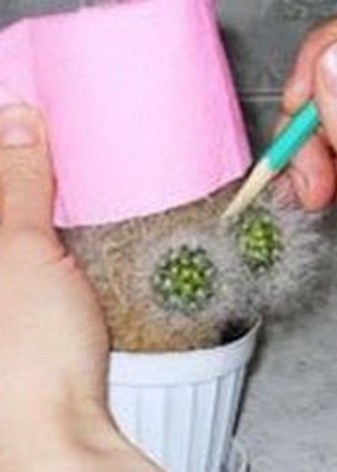
To prevent drying out, the seeds should be regularly sprayed with water. When shoots appear, it is necessary to remove the film. When thorns appear, this will mean that the young plants are ready to be transplanted into a permanent pot.
Growing difficulties
Growing a Mammillaria cactus at home, a florist may face such difficulties:
- the plant is not afraid of a lack of moisture, but its excess can cause unpleasant consequences;
- improper lighting will lead to the loss of decorative properties, the stem will stretch out.
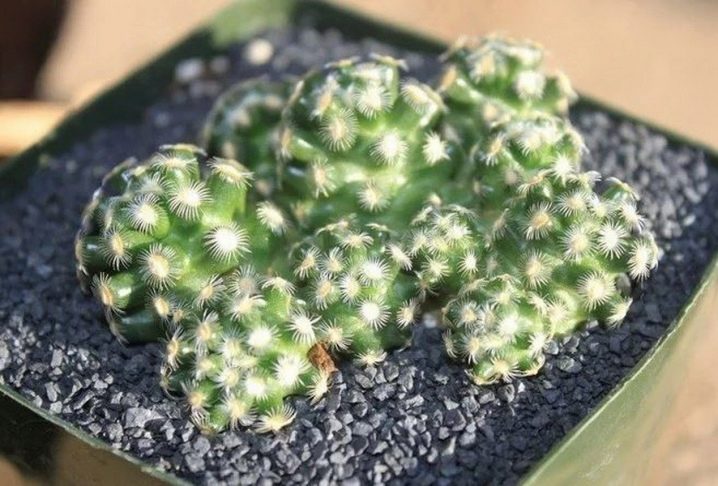
And it is also worth remembering that poor growth can be the result of lack of rest in winter, irrigation with cold water, frequent rearrangements from one place to another, and lack of transplantation.
Do not forget that a cactus, like any other living organism, can suffer from diseases and pest attacks. The next two types are considered the most dangerous parasites for mammillaria.
- Red spider mite. Its presence can be seen by rusty stains and dehydrated surfaces that are unable to recover. The fight against this insect involves repeated treatment with insecticides over several weeks.
- Cactus scale capable of infecting the plant and causing irreversible consequences. To eliminate the pest, it is worth treating with a high-quality insecticide.
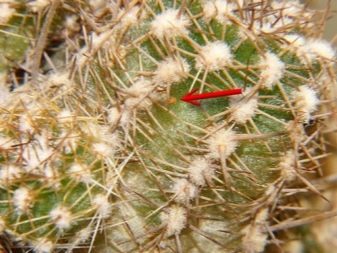
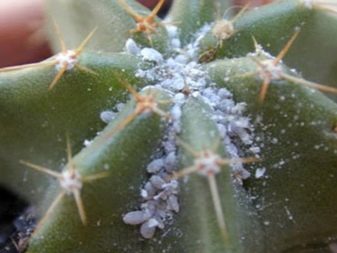
Mammillaria often suffers from phytophthora and spotting. In order to avoid infection with these diseases, regular preventive treatment with fungicides should be carried out. This type of indoor flower is also subject to rot infestation. If a problem is found, the florist must immediately remove the affected plant fragment: the event will save the cactus from the spread of infection and preserve its health.
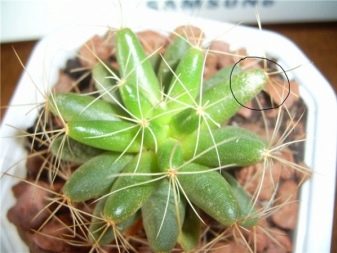
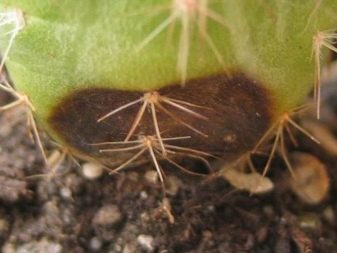
For information on how to properly care for the mammillaria cactus, see the next video.























































The comment was sent successfully.